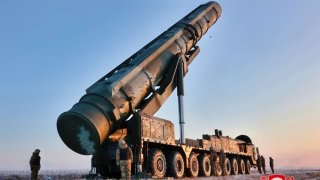North Korea's WMD Arsenal: Unveiling the Hidden Threat of Chemical and Biological Weapons
As Pyongyang continues to make nuclear threats, a detailed analysis of the country’s true nuclear and ballistic missile capabilities is important. But its stockpiles of chemical weapons should also be considered a grave threat.
Summary: This article delves into the persistent threats and belligerent actions coming from North Korea toward the United States, Japan, and South Korea, with a specific focus on its nuclear arsenal and Weapons of Mass Destruction (WMD) capabilities. It offers insights into the historical context of North Korea's nuclear program, its withdrawal from the Treaty of the Non-Proliferation of Nuclear Weapons, and its extensive nuclear testing. Moreover, the article sheds light on North Korea's suspected offensive chemical and biological weapons program, which dates back to the 1960s and includes the acquisition of dangerous agents like anthrax, cholera, and bubonic plague.
North Korea: A Chemical Weapons and Biological Weapons Threat?
North Korean leader Kim Jong Un’s government has threatened nuclear war and kinetic war with Japan, South Korea, and the U.S. in recent months. Pyongyang has also increased the pace of missile launches in the region, indicating that the nation is willing and capable of provoking its adversaries.
While analysts mostly focus on the threat of North Korea’s nuclear capabilities, Pyongyang’s arsenal of chemical and Biological weapons is also a worry.
What We Know About North Korea’s WMD
North Korea turned to the Soviet Union after World War Two to give its nuclear program a start. It paid dividends when the USSR built the Yongbyon Nuclear Scientific Research Center, finishing construction by the mid-1960s.
North Korea did ratify the Treaty of the Non-Proliferation of Nuclear Weapons in 1985, but it did not abide by the Treaty for very long, withdrawing officially in 2003. Since that time, Pyongyang has carried out several increasingly sophisticated nuclear tests.
In addition to its nuclear stockpiles, the DPRK is not a party to the Chemical Weapons Convention and is believed to oversee an offensive biological and chemical weapons program.
According to author Robert Collins, a former intelligence analyst with the U.S. Forces Korea Command, Pyongyang started to research biological weapons in the 1960s. Around this time, a germ weapons research organization was developed under the National Defense Science Institute, which led to the DPRK’s acquisition of anthrax, cholera and the bubonic plague. In an interview with The Hill, Collins added that Pyongyang’s hackers endanger South Korean chemical plants: “These hackers have also hacked into South Korea’s Chemical Accident Response Information system for the purpose of understanding where the South’s chemical plants are located and how much damage would result locally if they were subject to explosions.”
Seoul outlined the DPRK’s possession of anthrax, smallpox, and the plague in a 2018 white paper released by South Korea’s Ministry of National Defense. Analysts believe that North Korea in a future war could weaponize its stocks of phosgene, sarin, mustard and V-type chemical agents. At least 12 facilities are believed to be responsible for developing these chemical agents, according to industry experts.
According to IHS Jane, a 2017 analysis of Pyongyang’s biological weapons capabilities cites the following evidence:
-“On 17 June (2015), the RoK MND issued a report that stated North Korea possesses an assortment of biological agents - including anthrax and smallpox - and the ability to weaponize them within 10 days. The report also stated that the North did not yet possess warheads to employ bioweapons.”
-“During June 2015 North Korea announced that it has created a vaccine, known as Kumdang-2, that could treat Ebola, HIV, ‘a number of cancers,’ and MERS. Kumdang-2 was reportedly manufactured from ginseng grown in fertilizer made from ‘rare-earth elements’ and ‘micro-quantities of gold and platinum.’ Most serious researchers have significant reservations concerning these claims.”
-“In the aftermath of Kim Jong-nam's death in February 2017 due to toxic nerve agent VX, South Korea's MND was quoted by Yonhap News Agency as saying that North Korea's military is probably operating a regiment-level biochemical weapons unit.”
As Pyongyang continues to make nuclear threats, a detailed analysis of the country’s true nuclear and ballistic missile capabilities is important. But its stockpiles of chemical weapons should also be considered a grave threat.
About the Author: Maya Carlin
Maya Carlin is an analyst with the Center for Security Policy and a former Anna Sobol Levy Fellow at IDC Herzliya in Israel. She has by-lines in many publications, including The National Interest, Jerusalem Post, and Times of Israel. You can follow her on Twitter: @MayaCarlin. You can email the author at [email protected].
Image Credit: North Korean State Media.


